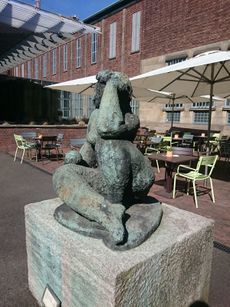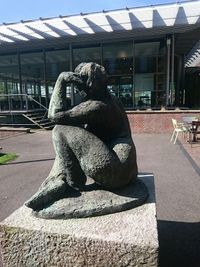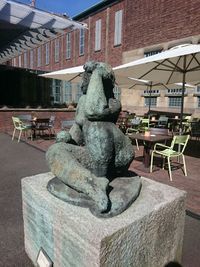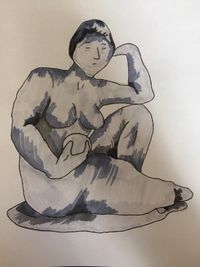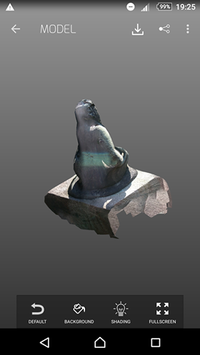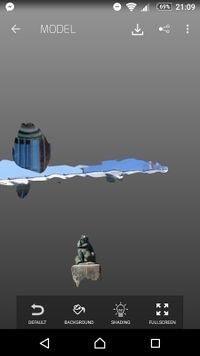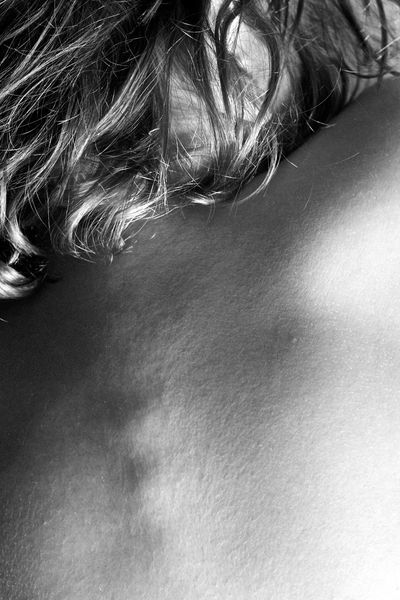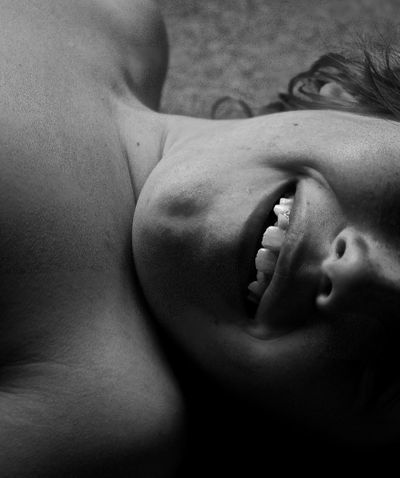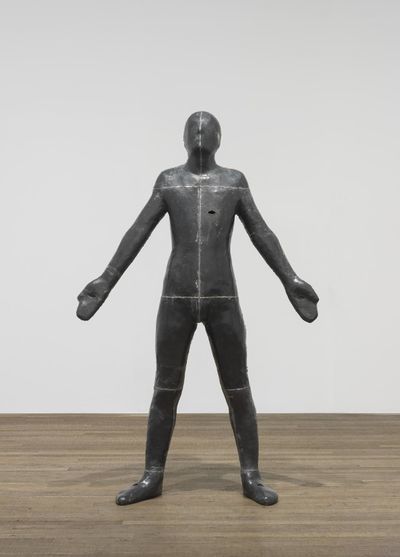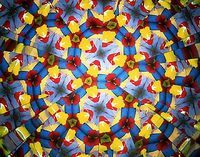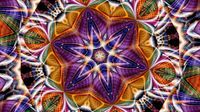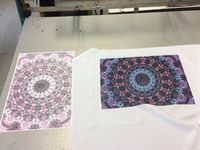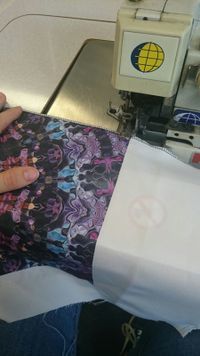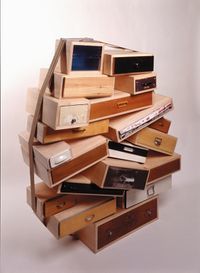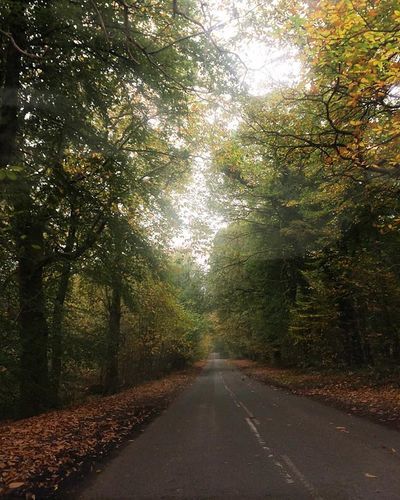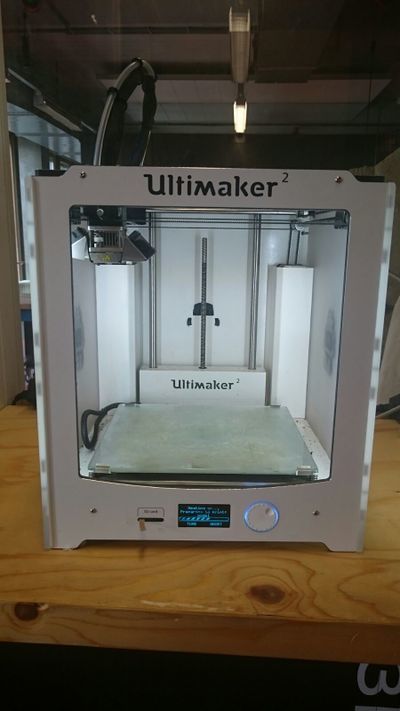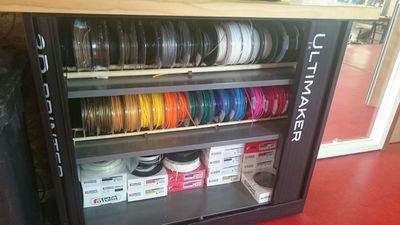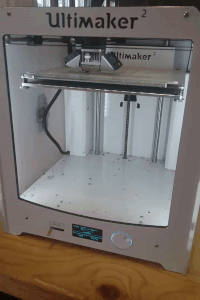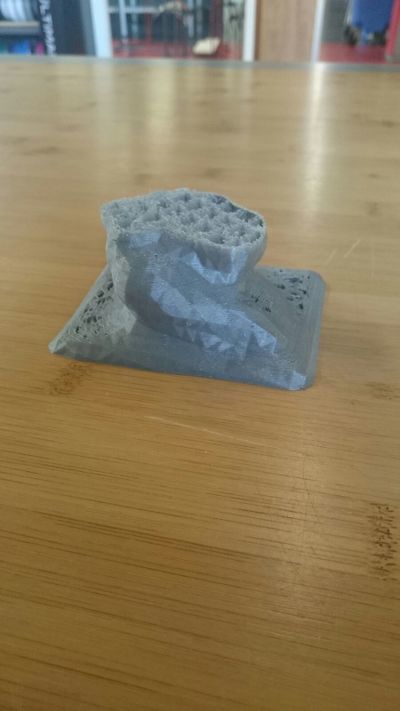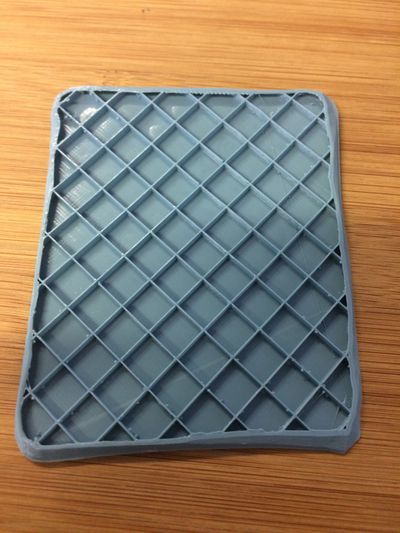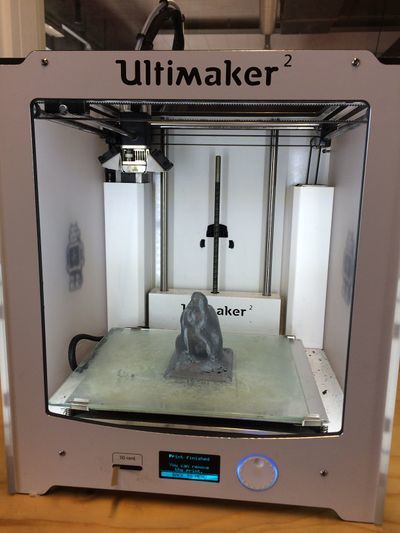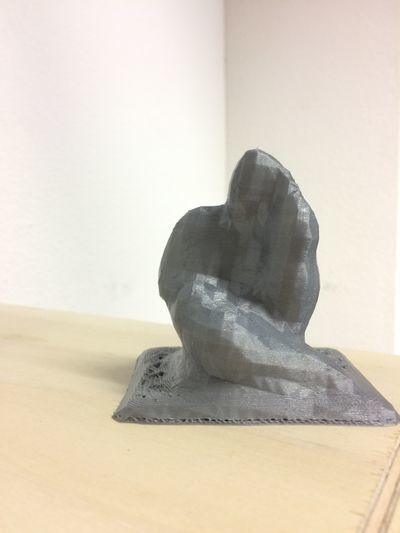User:Olivia Evans
FANTASTIC FORGERIES
| Contrafactual Past by Rik |
An italian woman preparing dinner on a hot day.The day the god Fortuna, god of fortune, fate and fertility leaves and makes place for Anteros, god of love and passion, women prepared a festive meal to celebrate the occasion. This day is often referred to as “giorno di riposo”, Literally translated to “Day of rest”. Where usually the locals of Acri (south of Italy) wore fabulous clothing to praise the gods, Anteros was praised by a day of openness and freedom. Since this day was not pinned by a specific date but determined by the harvest of tomatoes it was commonly associated by the refreshing of the soil. To prevent staining the soil with “unnatural” clothing, women and children were not allowed to wear clothes on the fields. The end of the harvest was celebrated by a grand meal. Pasto Prandi (Meal of rest) was a dish where green tomatoes were peeled and boiled with spices, and wine. This statue is a snapshot of a woman peeling tomatoes in preparation of pasto prandi. It is thought that this was originally made by an artist in Cosenza. Later was found out it was |
DIGITAL CRAFT/STATEMENT//
STATEMENT: CAN A WORK BE STOLEN AND REMADE WITH THE AIM OF REPLICATING THE FORM?
PLAN//
For the practice of Digital craft, I have chosen to focus on the sculpture of ‘Zittend naakt met appel’-(1957-1959) by the artist, Charlotte van Pallandt. The sculpture is made from Bronze and depicts a female form sitting thoughtfully. I have chosen this figure to appropriate as it interests me, I would like to focus on appropriating the human form with the main question in my statement being ‘can a work be stolen and remade with the aim of replicating the form?’ I aim to explore the possibilities of my statement and discover if it is possible to appropriate in such a way. I began the process by firstly photographing the work in order to document it digitally from a few angles.
A sketch that I have created of the sculpture that I have chosen to appropriate, I hoped the sketch would clarify my concept further. I plan to 3D print the sculpture using the 3D printer that is available for use in school.
After documenting it with my camera I plan to 3D print the form of the sculpture, focusing on really capturing the angles of the figure, therefore, appropriating and stealing from the museum; which is fitting for the course title for this elective, ‘Fantastic forgeries’. I then returned to the museum once again to 3D scan the object to prepare it for printing, I have placed a screenshot of one of the scans I made, using a total of 29 photographs stitched together. I have created a few scans of the sculpture to prepare it for 3D printing so that I can determine which scan displays the form of the figure best.
RESEARCH//
PRIMARY RESEARCH
I have carried out both primary and secondary research into several types of sculpture, both present and modern.
My primary research is experimenting with capturing the human form, as that is what I am interested in appropriating, I therefore photographed my younger brother to do this. I am pleased with the outcome of my photographs, I feel that all human form, detailed, simplistic, modern or ancient is appropriate as I am focused on capturing the form to appropriate the sculpture ‘Zittend naakt met appel’ (1957-1959) by Charlotte van pallandt.
SECONDARY RESEARCH (Please click on images for information included on researched artworks in the description, which includes the title, year etc!) I have focused on both classical and modern sculpture depicting the human form to assist me in my research progress, using secondary sourced images of works from various artists.
An Interesting example of appropriation that I have discovered and could possibly help inspire my own work: Paolozzi was walking past Harrods store one morning and saw a window dresser setting up a display which included a plaster cast of the head of Michelangelo's marble sculpture of David. He temporarily borrowed the cast from Harrods and had another cast made from it at the Royal College of Art. Paolozzi sawed his cast in pieces and glued wooden blocks in the cuts. The attack upon the cast is partly a comment on the great plaster cast collection of antique sculptures that used to belong to the Munich Academy of Arts, and which was largely destroyed during student riots in 1972. When Paolozzi was a student at Edinburgh College of Art in 1943, part of the teaching was to draw from casts of Michelangelo's David. (example of work shown below)
An Interesting, modern example of sculpture work by British artist Anthony Gormley. Gormley is famous for his artwork focusing on capturing the human bodily form.
SPECULATIVE FUTURE
For the work of the speculative future task I have focused upon Dora's chosen artifact of 'Floor piece' (1976) by artist Sol LeWitt. I have included an example of the artwork displayed in the Boijmans museum below.
Dora said that the work to her is like an optical illusion, almost like a kaleidoscope. I decided to take this concept that she has created for her work and speculate how it could be used within the future. I feel that kaleidoscope imagery is incredibly futuristic and modern. I felt that this imagery could be used in the future fashion industry, as a style of futuristic print for fashion designers to incorporate into their clothing. Especially as art and architecture now heavily influence the fashion industry. I therefore made prints of kaleidoscope images and used the sublimation printer to print them on to polyester. It was only possible to use synthetic material to print upon to create the best results and allowing the ink to bind to the fibers. To finish the work, I over locked the fabric to neaten the edges of the samples
Images of my process.
Although these fabric samples are just a prototype, if I had more time to dedicate to this work it would be interesting to see what would happen to make these clothes into modern garments to match the concept of 'speculative future'
CONTRAFACTUAL PAST
I was tasked to create a fictional past for the work 'you can't lay down your memory', (1991) by Droog design. This being the artwork that Rik has chosen to appropriate for the fantastic forgeries project in Digital craft. To create a fictional past for this work I have decided to create the drawers into a character, possessing its own persona and feelings, being able to tell its story through a text artwork. I have taken inspiration from my own surroundings of where I live in England, directly next to Delamere forest where I see logging companies often remove trees to be used for the wood industry. I have tried to imagine what the origins would be of the cabinet, and I have then made the written piece, and printed it on paper clearly, so the main focus is on the words within the text.
I was chopped down from the forest, left lumbered on the ground.
Taken from my roots, I have been disturbed and destroyed, for I shall not grow upon the forest floor.
I am transported and then transformed into wooden planks. I am bent, contorted with rough hands, nails stick within me forming the structure to which I am destined to be; a drawer to be overstuffed with items belonging to my new owner.
I am now forever bound to be a holder of belongings.
I am no longer free to grow, I am halted in time.
DOCUMENTING THE DEVELOPMENT OF MY WORK
I have documented the creative working process of making my appropriation piece and its transformation. As I have previously stated in my plan, I wanted to 3D print the scanned models I created whilst visiting the Boijmans museum. I did this by uploading the model onto software, preparing the size and file, then exporting it to the 3D printer with the SD card that can be slotted into it. I chose to use a silver/grey colour for the printing process of my model, as it allows the viewer to concentrate on the form. Focusing on the form of the model is my main goal, as it is my concept to carry on the appropriation of the art work, 'Zittend naakt met appel.' A few images of the process.
Although, it did not go all to plan and print as I had hoped for. The 3D printer shut down due to the reel holding the material becoming tangled. This meant it did not complete the model, it only printed half of the design. It was very disappointing, although it could not be helped. It means that I now have some experience in the problems the 3D printer can encounter. I have included a photograph of the unsuccessful attempt below.
ATTEMPT NO.1
ATTEMPT NO.2 I was extremely disappointed when my print, yet again, failed. I have documented the process of this and the outcome below my taking photographs. Unfortunately, I think it is common to have issues with the 3D printers as they are sensitive and encounter issues easily.
ATTEMPT NO.3
After I failed to successfully print the model first and second time around, I have tried again once more, and it was a success! I watched the 3D printer carefully this time as I was worried that mistakes or faults would occur once more. I am pleased with the outcome as it has captured the form of the sculpture 'Zittend naakt met appel' as I had intended.
I feel that the outcome is a transformation of the two unsuccessful attempts, as this time it managed to capture the form perfectly. This is in comparison to the two failed attempts that do not capture the form of the sculpture and are misinterpreting it as they are deformed and incomplete.
A photograph of my model upon completion inside the 3D printer.
I then removed the finished 3D model using a spatula as it can become stuck to the printer bed.
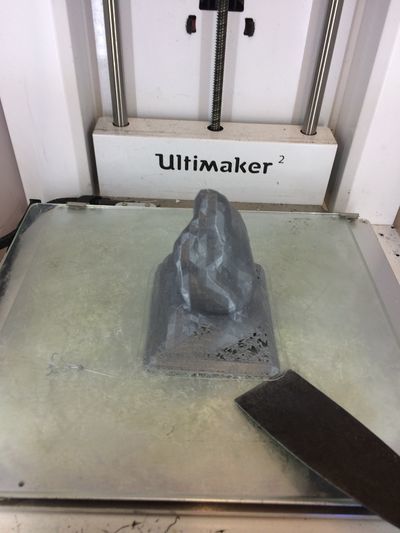 A photograph of my finished piece. I am very pleased with the result as it has captured the human form of the sculpture as I had hoped for. I feel my process has been justified as I have successfully carried out research and an appropriation as I had intended in my statement before starting this process.
It is now incredibly intriguing to me that this process of stealing from a museum and creating a ‘fantastic forgery’ is entirely possible, which leads me to wonder, if everyone can make their own what consequence does that create to the original piece’s value and meaning?
A photograph of my finished piece. I am very pleased with the result as it has captured the human form of the sculpture as I had hoped for. I feel my process has been justified as I have successfully carried out research and an appropriation as I had intended in my statement before starting this process.
It is now incredibly intriguing to me that this process of stealing from a museum and creating a ‘fantastic forgery’ is entirely possible, which leads me to wonder, if everyone can make their own what consequence does that create to the original piece’s value and meaning?
A GIF of my finished model.
REFERENCES// USING THE APA REFERENCING SYSTEM
- Home. (n.d.). Retrieved from https://www.boijmans.nl/
- (n.d.). Retrieved from http://www.antonygormley.com/
- Tate. (n.d.). Sir Eduardo Paolozzi 1924-2005. Retrieved from http://www.tate.org.uk/art/artists/sir-eduardo-paolozzi-1738
